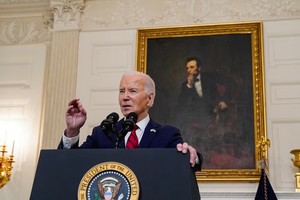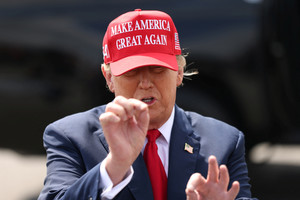When Red and Blue America Are on Different Planets

Both Joe Biden and Donald Trump were in New York City last week, on the same day and just a few miles away from each other. They may have just as well been on opposite sides of the solar system.
Biden spent Thursday night at Radio City Music Hall, flanked by two former Democratic presidents, basking in the applause of celebrities and millionaires, and raising an unprecedented $25 million for his already-bulging re-election coffers. This was an extraordinary show of political and fundraising clout, designed to demonstrate that even a president who is running behind in the polls still commands a formidable amount of political power with which to wage his re-election campaign.
Trump’s campaign knew that they could not compete with the media attention that Barack Obama, Bill Clinton, Steven Colbert and other headliners would generate. So they smartly pivoted in the opposite direction, sending their candidate to attend the memorial service of a slain New York City police officer in the most Republican bastions of Long Island that afternoon. The photos of both events almost perfectly encapsulated the contrast that has developed between the last two presidents, illustrating the policy and cultural differences that separate them and their supporters.
To be fair, Trump certainly has access to a considerable number of wealthy donors too (in fact, his campaign will hold a fundraiser this week that may eclipse Biden’s haul). And Biden has long demonstrated an ability to successfully reach out to both the law enforcement community and the broader working-class cohort whose socio-economic interests police officers tend to share. But their two events last week reflected the distance between their constituencies, the advantages on which both campaigns can rely as the election year proceeds, and the challenges they will fight to overcome over the next seven months.
Biden’s advisors would protest this “cops vs. celebs” portrayal, with some justification. But while his supporters are certainly not all millionaires, today’s Democratic Party has been successful at drawing not only donations but an increasing number of votes from economically upscale Americans. Conversely, one of the most important keys to Biden’s victory in 2020 was his ability to attract white working-class support at levels that most politicians in his party are unable to match. But Trump has made inroads with these voters during his time out of office, and his emphasis on crime and immigration policy has been an important part of that success.
At the same time, though, Trump has had problems with some of the wealthy suburban voters who had been part of the GOP base for decades. Nikki Haley’s supporters reflect that demographic, and they have been noticeably hesitant to shift their backing to Trump. The Biden campaign is aggressively reaching out to them both with paid advertising to attract their votes and more personalized appeals to secure their dollars. While Trump has plenty of zillionaire backers of his own, his campaign’s broader fundraising efforts have struggled, and the donor-class defections are one of the reasons for those difficulties.
This election is certainly not going to be decided in either midtown Manhattan or suburban Long Island. But the support that Biden and Trump each draw from these respective communities reflects the growing cultural divide that separates red and blue America. There’s some irony in the fact that Middle Class Joe of Scranton, Pennsylvania, is the favorite of the moneyed classes while billionaire Fred Trump’s scion Donald draws such enthusiasm from blue-collar voters. But the shifts that have taken place in the electorate over the last half-century have less to do with the personal biographies of these two men than a more fundamental re-sorting of American political allegiance according to culture rather than income.
For most of this country’s post-Civil War history, the most reliable indicator of partisan voting behavior was financial status. But that stark division began to fade in the late 20th century and the change has accelerated over the last twenty-five years, as religious, educational and rural/urban identifiers have become more prominent. In the past, moving from one America to another could be simply a matter of a job promotion or dismissal, an investment windfall or a bankruptcy. But now that step requires a more fundamental reexamination of the values one holds closest. Not surprisingly, switching between parties is now much less frequent, and the partisan walls grow higher.
Biden and Trump demonstrated last week how wide this divide has become. They will continue to show us almost every day until November.
Want to talk about this topic more? Join Dan for his webinar "Politics In The Time of Coronavirus." Or read more of Dan’s writing at: www.danschnurpolitics.com.
Dan Schnur is a Professor at the University of California – Berkeley, Pepperdine University, and the University of Southern California, where he teaches courses in politics, communications and leadership. Dan is a No Party Preference voter, but previously worked on four presidential and three gubernatorial campaigns, serving as the national Director of Communications for the 2000 presidential campaign of U.S. Senator John McCain and the chief media spokesman for California Governor Pete Wilson. He has a Center bias.
This piece was reviewed and edited by Isaiah Anthony, Deputy Blog Editor (Center bias).
Photo Credit: New York Post via AP

May 1st, 2024

May 1st, 2024

April 29th, 2024

April 29th, 2024